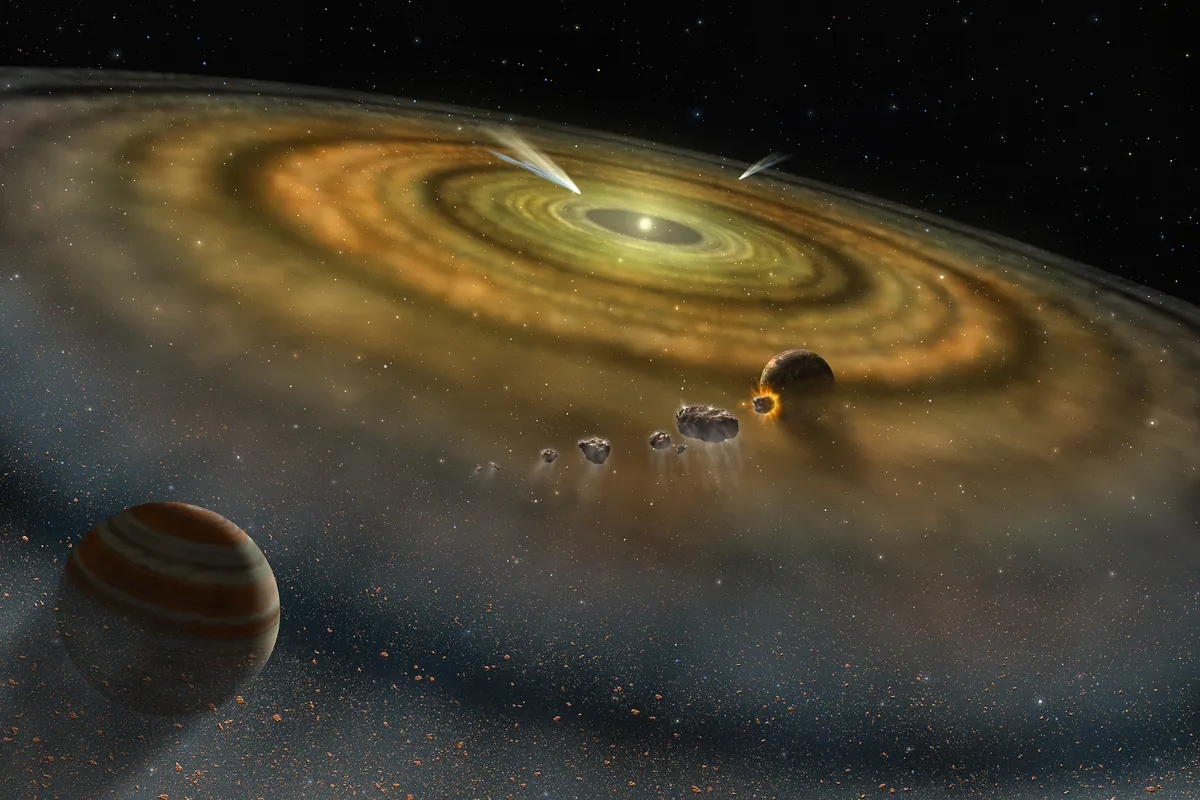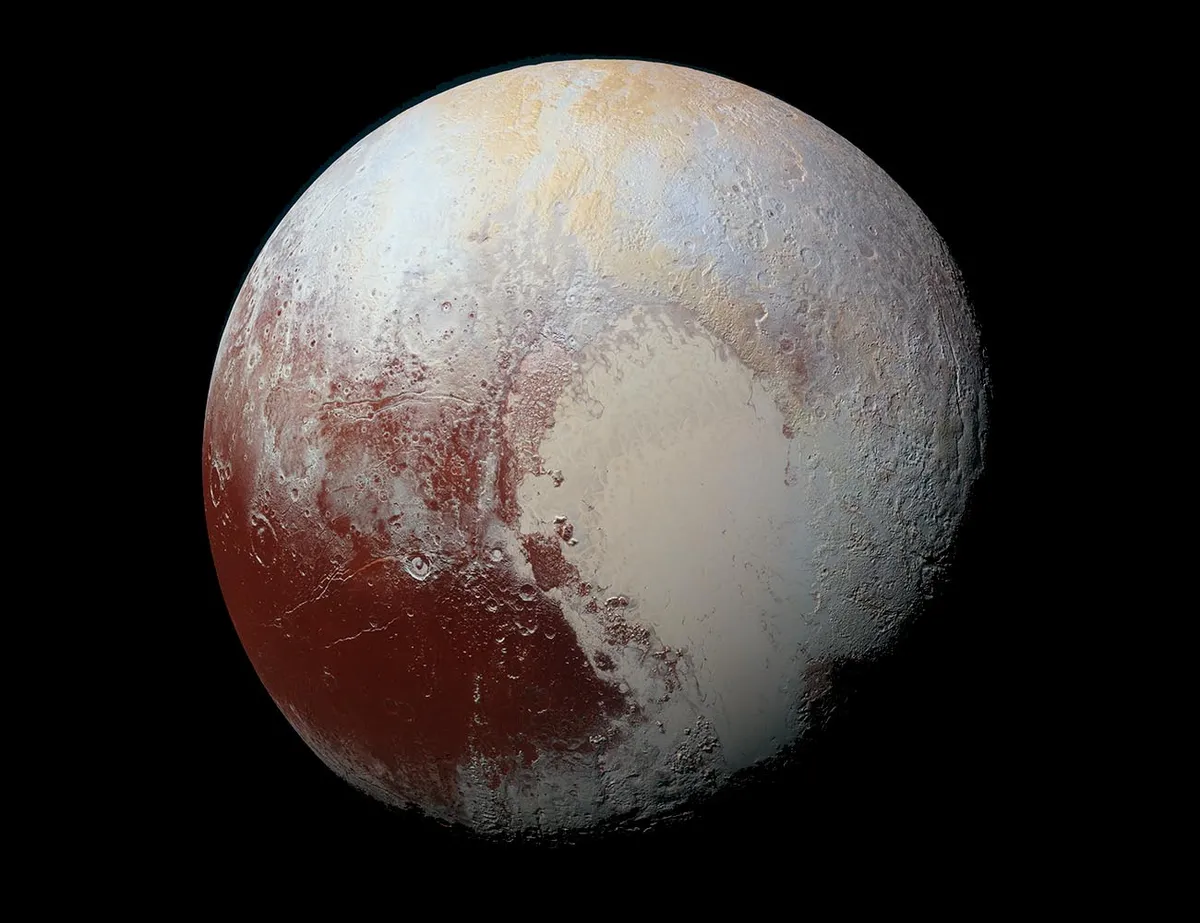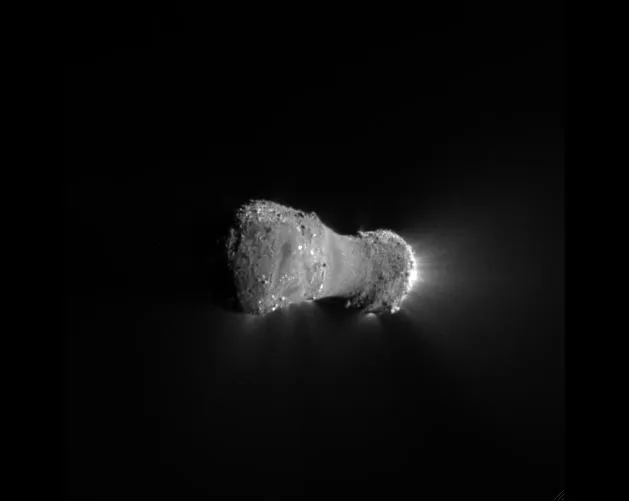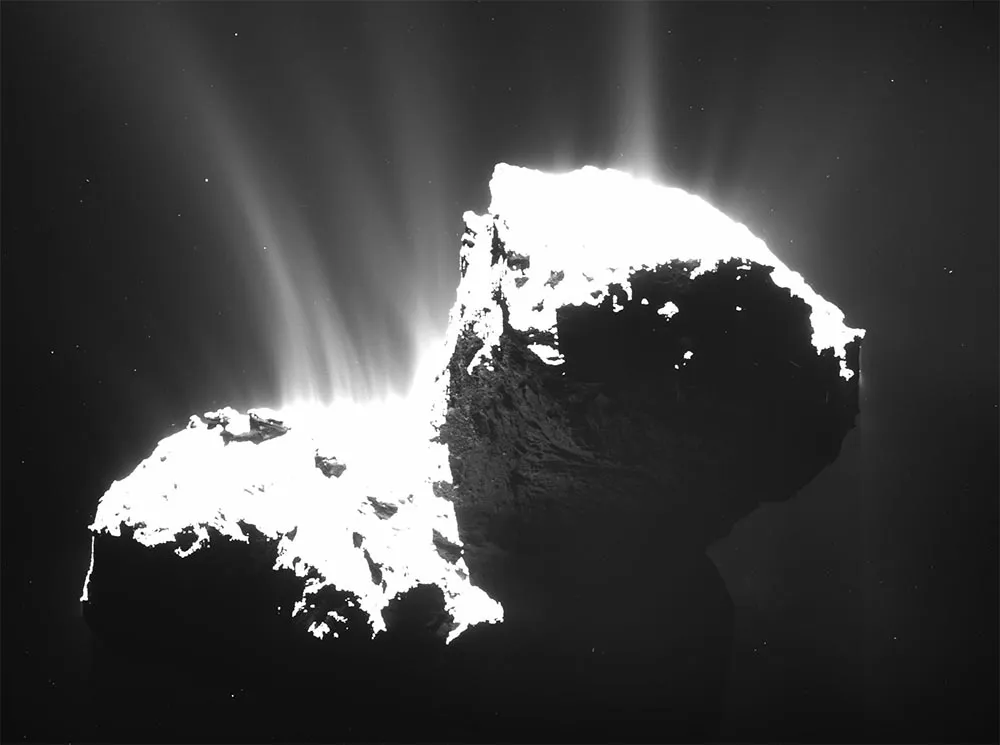The New Horizons spacecraft revealed the features and geology of the distant dwarf planet Pluto and its moons like no other mission before it. Once its mission at Pluto was complete, New Horizons flew further out to the edge of the Solar System to study a ring of rocky, icy debris known as the Kuiper Belt.
On 1 January 2019 it flew past Kuiper Belt object 486958 Arrokoth, beaming back images and data about this primordial piece of the Solar System and giving scientists a closer look at the material out of which the comets, planets and asteroids formed.
BBC Sky at Night Magazine got the chance to catch up with Carey Lisse, one of the mission scientists, to find out what the results from New Horizons' flyby can tell us.

What is the Kuiper Belt, and why are we so interested in studying it?
The Kuiper Belt is the edge of the original disc out of which the whole Solar System formed.If you go back about five billion years, a giant molecular cloud - something weighing about ten times the mass of our Sun - started collapsing.
As it collapsed, about 99.99 per cent of the mass fell to the centre and became the proto-Sun, the young Sun.A very small fraction of that material didn't fall into the Sun, but actually turned into a spinning disc around the Sun.
That disc eventually clumped and collapsed and turned into the asteroid belt and comets and Kuiper Belt objects, and then into planets. That's how you build a mature Solar System like the one we live in today.
That disc has an edge where there isn't enough mass to make big things like planets, but there is enough to make comet-like objects, which are very cold because they're far away from the Sun.It makes little and big snowballs, and those are Kuiper Belt objects.
486958 Arrokothis the first one we've ever flown by. It's a small to medium-sized Kuiper Belt object.
Was theArrokoth flyby a last-minute mission extension, or had you always known that you were going to take a look at the Kuiper Belt?
The official name of the New Horizons mission is the Pluto Kuiper Express.
The job was to go by the biggest thing in the Kuiper Belt, which is Pluto, and then to go and visit a medium to small-sized Kuiper Belt object, and we've fulfilled both of those basic requirements.

How do scientists actually receive the data from New Horizons, and what do they do with it in order to produce scientific results?
You have to consider the bigger picture really, which is that we performed this fantastic flyby on 1 January 2019, and the really good data all came within about plus or minus 12 hours of closest approach, which happened about 3,500km from the object.
The object is about 35km across, so we went about one hundred times further from it than its own length. It's going to take us 20 months to get all the data.
We took pictures, we took spectra, we even did a radio measurement of the object. We measured the solar wind around it.And we did all this as we were screaming past at 14 kilometres per second.
We have lots of images and spectra, but we also have a very poor data link.We have a kilobyte-per-second connection between our spacecraft and and Earth.A lot of that is just because we are 45 times farther out than Earth is from the Sun.
We're far, far away, and we only have a dish that's about a metre across.
I like to say we have a worse connection than dial-up! If you've ever tried to load a web page and you've seen it go line by line by line, you can go out to the kitchen and make a cup of coffee for 20 minutes then come back.
We've got that kind of connection, so it's going to take us 20 months to get all the data from this very short, very fast flyby.
Is all this data actually publicly available to scientists around the world, or is it only available to NASA scientists?
If you go to the official NASA and JPL web pages you can actually see the latest images as they're downloaded and put up there.We're trying very hard to keep strong and quick connections to the public.
As this data is coming down, we are working on it and we're coming up with new ideas every week.Our imaginations and our theories are proven or disproven.
What you're seeing is a process of geologists and astronomers and chemists from around the world coming together and trying to figure it all out as we learn more and more.

What has the data revealed?
There's so much going on with 486958 Arrokoth. There are two very different sized lobes, yet they seem to be the same colour.
There are depressions and holes all across them.There's a neck where the lobes meet that can tell us about how they came together, and it's a different colour.There are lots of clues inArrokoth that we are still puzzling out.
We presented three months' worth of learning in March 2019 at the 50th Lunar and Planetary Science Conference.
This conference began when the Apollo astronauts brought back the first moonrocks.
We're now at the 50th anniversary of Apollo 11, of humans walking on the Moon, and at the conference this year we had our big reveal about what we'd learned in the few months after the flyby.
What have we learned about 486958 Arrokoth's odd shape and how it was formed?
That's the big news.We don't know anything about the dark side, as it was un-illuminated.We flew in perpendicular to Arrokoth's rotation, so we only really know what's going on on one side.
But what we've learned after sitting down and scratching our heads a little bit is that it's what we call a 'cold classical Kuiper Belt' object.
It's not cold because it's far from the Sun; it's dynamically cold. Its orbit has been pretty much the same for the entire history of the Solar System.
486958 Arrokoth formed and has stayed where it is for 4.6 billion years.This is good because it means it's a very primordial object.
But then we scratched our heads and thought a little bit more, and we realised we had to be a little bit careful, because the very top surface of the body can get scoured and damaged and changed by a little bit of sunlight, but also by micrometeorite impacts.
We thought a bit more and we realised that every few hundred million years, a very bright star, much brighter than the Sun - ones that don't last very long and which blow up and turn into supernovae - come within 30 lightyears of our Solar System.
So that could heat up 486958 Arrokoth. It's normally about 45° Kelvin, but they could heat it up to 60° or 70° Kelvin.We realised that could affect things on the surface down to maybe as much as ten metres.
So we have to be careful because the top ten metres may not be primordial in the 4.6 billion-years sense, but they're probably a few hundred million years old.
That being said, we think the merger between the big lobe and the small lobe is itself primordial.So the age of the object changes depending on the depth that you're looking at.

486958 Arrokothhas two lobes. The big one, which is about 9km radius, looks rather flattened, and the small one, which is about 7km radius, looks to be pretty roundish.
Think of them as two relatively large mountains: the Cotswolds in the UK, or the Appalachians in the US.
Remember that this is material that's ice and rock in dust form - finer than your hair up to maybe the thickness of a fine wire - that all loosely collected together in the early Solar System, with about 70 or 80 per cent porosity.
Even though it looks solid, it's mostly vacuum.
But these are two large mountains that came together, we think, very slowly, perhaps only a few millimetres per second.
So if you want to reproduce this at home, you can go and walk into a wall!
Think of it like two mountains coming together very slowly, like a train wreck, and because they're loose and porous and fluffy, they probably came together right where the current neck is, and then they stuck.
We do not see any evidence for a more violent collision other than a very narrow line.
It doesn't look like they rolled; we don't see big breaks where they came together.
When we look at how it's rotating, we think that right before they stuck together they were rotating just like Pluto and its moon Charon, tidally locked.
They were already very close together and when they merged they just clicked into place.
The larger lobe looks like it has a central lobe and then four different pieces that came together, probably as sub-units, and it's pretty natural to think, because it's so flattened, that they were just a group of objects that were spinning around together and they finally clicked and stuck together on their own.
The smaller lobe looks to be a pretty large, concrete unit.
It does have a hole. It looks like it was impacted by a crater that created a hole about 7km across and 2km deep. So we think it got impacted.
When we look at the pits all over it, we see a bunch of small depressions along the edge, and we see just a few in the centre.
We do not think that is a real distribution, we think it's an artefact.
When you look at the full Moon and try to see craters, they're hard to see because they have no shadows and light regions; no contrast. They are totally illuminated.When we flew into 486958 Arrokoth, the Sun was right behind us.
But we do see a lot of pits along the edges. And we see a lot of small pits that we think are due to sublimation, rather than impacts. We think they're different than the really large one I mentioned.
486958 Arrokothformed in a spinning disc around the Sun. When it was first forming, the disc was very thick; we call it 'optically thick'. Like a very dense fog of gas and dust.
So we think it formed about the same temperature as the Galaxy, about 20° Kelvin.At this temperature even methane, nitrogen and carbon monoxide will solidify.
But then as the disc dissipates and all the comets, asteroids, planets and Kuiper Belt objects move apart, suddenly space is clear again, like it is now.That would mean that the surface of Arrokoth would have heated up to about 40° Kelvin.
And the Sun itself has actually warmed up since it was very young by about 30%, so we think it's even gone up to about 45° Kelvin.
That temperature is more than enough to boil methane, nitrogen and carbon monoxide, so the ice could have sublimated straight into gas and made the pits that we see.
Those are the same gases that we see in Pluto's atmosphere, and we also see them condensed in Sputnik Planitia, Pluto's heart-shaped feature.

Unlike Pluto, 486958 Arrokoth has almost no gravity, so if ice starts evaporating, the gas is just lost into space.
Everything we've learned about Pluto's atmosphere we can apply to Arrokoth, and more. So it's kind of cool that we can connect them.Just from pictures of the shape and structure, we can learn an awful lot about this object.
One of the big questions is "what was the cloud of stuff that 486958 Arrokoth formed from?"
We're still working on that. There are models showing how tiny pieces of dust and gas and form ball bearings and marbles, and then from those marbles orbiting the Sun come bigger, mountain-sized objects, but we're still figuring it out.
We've taken pictures of the two lobes in four different colours, and we've done spectra across them.
What we see is a body that's very red. The two lobes look identical.
We have a very strong indication that they didn't form in two different parts of the Kuiper Belt; we're pretty sure that they formed in the same swarm of material.
We've looked at a few hundred binary objects in the Kuiper Belt, and we see a huge range of colours from red to blue, but we always see pieces of the same colour together.
That's telling us that in this big disc there were lots of little clumps, and they individually collapsed and formed a few pieces that then stuck together.
If we look at the Rosetta comet, 67P/Churyumov-Gerasimenko, and the NASA Deep Impact comet Hartley 2, they both consist of two lobes.
There were big discussions when I was part of the Deep Impact team.
Was Hartley 2 two individual pieces that came together, or was it one big round object that had a particular rotation axis that caused the equator to get eaten away?
Imagine if Earth was made out of ice. We know that the equator is the warmest place, so Earth would eventually turn into a dumbbell with two large lobes at the top and bottom.
We now think that 486958 Arrokoth is the parent of all the other comets we see in the Solar System, and it certainly looks like they were made by two different objects coming together.

One of the most interesting things about the Rosetta mission is the topography it has revealed on Comet 67P, with cliffs and boulders. What would it be like if we could stand on 486958 Arrokoth?
On 67P the gravity is about one millionth of what it is on Earth, so you could stand on 67P and easily jump off!It's so loose and weak you'd probably crunch into the ground, too. Arrokothhas about one hundred times more gravity, because it's ten times bigger, but its gravity is still very weak.
Its gravity is actually very flat, but the neck part turns out to have stronger gravity, so you would want to roll down to the centre. You'd be walking along and suddenly fall downhill into the neck.
It would be like one of those Escher paintings, where you're walking along and suddenly the staircase goes sideways!
That's why stuff rolls downhill and dumps into the neck, and that's where we see a slightly brighter band of material, where dust and particles have been knocked off the surface but didn't fly out into space because they were big enough to fall back down onto the object, and they rolled downhill.
Considering the discovery of organic molecules on asteroids and comets and Kuiper Belt objects, might these bodies be able to tell us how life arose on Earth?
We got spectra of the surface of 486958 Arrokoth, and it's a pretty uniform, reddish surface.We see three absorptions that we think are indicative of methanol and water, and one other thing that we're still identifying.
I've run an analysis using all the things we think are in comets like 67P. Everything from ammonia to carbon monoxide. All the simple molecules: methane, ethane, water, hydrogen cyanide.
When we do that, we find that there are only four molecules that should have remained stable onArrokoth over the course of the life of the Solar System: ammonia, hydrogen cyanide, methanol and water.
We've looked for the signature of ammonia and we haven't seen it. We are still looking for hydrogen cyanide, but the spectra are a little bit rare because it's a very poisonous material.
But we've found very good evidence for methanol and water.The interesting thing is that the amount of methanol that we see on this object looks like it could be 10 to a hundred times what we inferred from the gases on 67P.
Scott Sandford of NASA Ames Research Centre told me that the way methanol would be combined with water ice means if you heat them up to just 70° or 80° Kelvin, they'll dump most of their methanol out but keep the water ice.
So 486958 Arrokoth might have a lot more methanol than we've inferred from a heated-up and slightly processed object like 67P.
We may be learning that the raw materials that went into the first comets, the proto-comets that then built the planets, could be a lot richer in some of the ices than we thought.

Did we see geological activity and gases bursting out from below the surface on Arrokoth, like we did on 67P?
Actually, what's interesting is the things we didn't see.We did not see any evidence of moons around Arrokoth. A moon would have told us the mass of the object directly.
We did not see any rings either, nor any evidence of an atmosphere around it.We did not see any evidence that the solar wind - particles streaming from the Sun - were perturbed by it.
Ultimate Thule is basically small and inert. In one way that's bad because we don't see all the fun geology that we saw with 67P, but in another way it's good.It means this object really is quite pristine. It's just been sitting there in deep, cold freeze.
There's one other important discovery.
486958 Arrokothlooks very round, and we have to be very careful because we only have 30 metres per pixel resolution from our flyby, but if you look at 67P, it's very rough; it's got ridges and scarps.
Many of us thought that you would get all kinds of interesting structures on an object as stuff just comes in and sticks, but it could be exactly the opposite.
It could be thatArrokoth formed relatively smooth and benign, but a process called 'mass-wasting' - where ices sublimate and evaporate and take dust with them - makes all kinds of rough ridges and ripples and landslides on the inner Solar System comets.
So we think there might be quite a different progression from a Kuiper Belt object like 486958 Arrokoth to a comet like 67P, even allowing for the fact that we imaged 67P at a much higher resolution.
It sounds like there is a lot more to learn. Are you looking forward to the coming data dumps?
Absolutely. This is just as exciting and fun as it was with Pluto. Pluto went from a blurry blob to an object with geological structures, glaciers and mountains, rifts and valleys and craters.
We're doing the same thing withArrokoth.
It was terra incognito before the flyby. And now we're seeing that this Kuiper Belt object is an undisturbed, pristine relic from the very beginning of the Solar System.
As much as we love Pluto, it is round, which means it absorbed lots of Kuiper Belt objects, but they melted and flowed and gravity worked on them.
That has not happened with 486958 Arrokoth. We are just at the very beginning of scaling the mountain and learning all about it.
I wouldn't be anywhere else. This is exploration at its purest. This is a brand new piece of territory that we've never discovered before.
